Our Binary System
Imagine you're in a spaceship travelling past a star-forming region of the Milky Way galaxy. In the dense swirls of gas and nebula debris shine many bright young stars. They vary in intensity, and in size. Surprisingly, you see not just stars the size of our Sun, but also the bright stellar fires of much smaller 'stars'. Some of these brown dwarfs are not much bigger than Jupiter, yet in their primordial state they are glowing with their own intense red light. In the star-forming clusters, the brown dwarfs actually outnumber the stars. Some of them are completely separate from the stars, some of them orbit their larger brethren more closely.

A third set of these brown dwarfs can be spotted orbiting their companion stars at a great distance. You take a close look at one pair; a mainstream star forming alongside a more faint, red companion. Each is enveloped by a cloud of circulating dust. But the distance between them is far, far greater than the size of the larger star's proto-planetary disk.
As you study the pair over time, it becomes clear that there is an orbital relationship between the star and its companion brown dwarf. They form a wide binary, with the brown dwarf slowly swinging around the mainstream star at a distance which is hundreds of times that of the star's more regular planets.
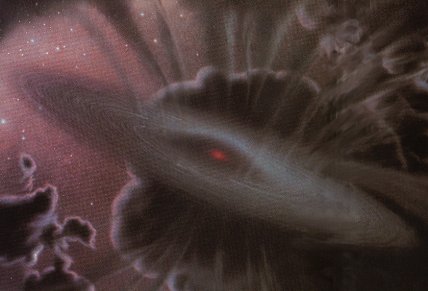
New data provided by Professor Kevin Luhman shows cases where brown dwarfs are seen forming binary systems with their larger mainstream star companions at immense distances. One such dwarf is about 500 Astronomical Units away, and this brown dwarf is forming its own planetary system as it orbits its mainstream Sun. We know that brown dwarfs outnumber stars, and that they are to be found floating freely in interstellar space, as well as appearing in star systems in a variety of ways. Thanks to Dr Luhman's work it is clear that brown dwarfs may proliferate as binary companions.
Brown dwarfs shine brightly for only a short while however. Dependent upon their mass, which can vary from about 12 times that of Jupiter to about 80 times, they will burn up their available fuels in a rash of youthful intensity. But they are not big enough to trigger the nuclear chain-reactions which make 'real' stars shine for billions of years.
After a period of just millions of years, these brown dwarfs burn out, and darken. That has made them very difficult to spot. Only the very young brown dwarfs in the stellar nurseries have been bright enough to image directly. The older brown dwarfs, which form the vast majority of these objects, are effectively invisible to our telescopes. Despite being commonplace, the overwhelming majority of them have evaded detection, even in our quiet galactic neighbourhood.
The implication of this is that there are a great many of these objects orbiting stars which we have assumed to be singular. In these cases, the companion brown dwarfs make them invisible wide binary systems. This adds a whole new layer of complexity to our understanding of star systems, and their planetary systems. It means that not only might there be planets circulating the star, but there might be more planets which are orbiting around the dark companion. Perhaps the majority of the stars in our skies are configured in this way. Perhaps the majority of them have dark companions whose presence has yet to be detected.
Such a state of affairs would possibly double the number of planets in the Milky Way.
Our System
Your spaceship has just been fitted with a brand new engine, allowing time-travel. You chose to set the dial to a era some 4.6 billion years ago. You are keen to gaze upon the Sun's birth, and you expect to see a great proto-planetary disc forming out of the whirling gases of the Sun's stellar nursery.
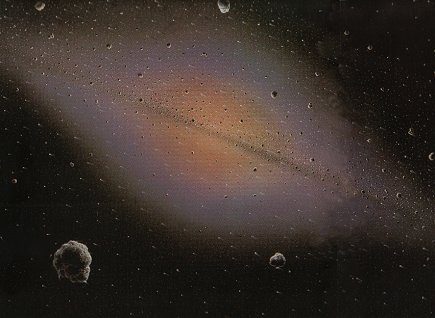
Because of the potential dangers you set the coordinates to a light year distant, so that you can train your ship's instruments on the Sun's entire fledgling system from afar. You expect to see something like the image above. After all, the Sun is a single star, its planets arranged in an orderly manner. Everyone knows that.
With a great flash of light and a shudder, your spaceship leaps through time and finds itself a light-year from the Sun. Immediately you realise that you have underestimated the situation. Your ship is inside a colossal star forming region. All around you are new stars, and new brown dwarfs. The intensity of the light outside your ship's windows is incredible, and spectacular. So, the Sun formed in a cluster, you realise, and you train your telescope towards the Sun's own location. Amazed, you stagger back from the ship's instruments.
This is what you just saw:
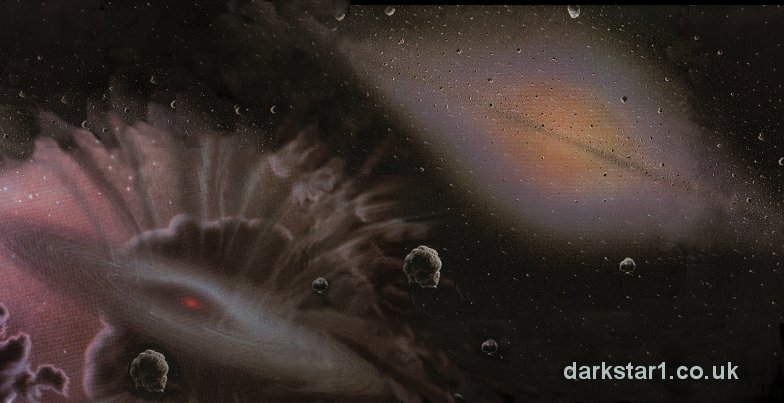
Science fiction? Not at all.
We know that brown dwarfs can form as a companion 'star' in a wide binary orbit. One has been seen some 500 Astronomical Units from its companion star. That's five hundred times the distance from the Earth to the Sun. Our current knowledge about the contents of our solar system extend to only a fifth that distance. Beyond about 50 Astronomical Units the collective body of orbiting dwarf planets, or which Pluto is one, seems to stop. We know that the shape of this outer belt, known as the Edgeworth-Kuiper Belt is irregular, that it has been affected in the past by a massive body. That could take the shape of a companion brown dwarf, just as much as it might have been caused by a passing star. Something has 'swept out' this zone, like a massive cosmic vacuum cleaner.
There are a great many solar system anomalies which remain unsolved. We know that the distribution of comet influx is non-random. We know that several of the most distant objects ever seen in the solar system have bizarre orbits, perhaps caused by a more remote, and massive force.
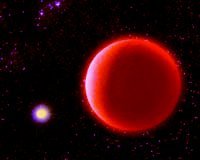
We know that some considerable time after the solar system settled down, it was barraged by a host of objects over the course of a hundred million years. Where did these objects come from? Many solar system bodies show the signs of massive catastrophic impacts.
Most importantly of all, we know that brown dwarfs can form far beyond the normal planetary zone, when star systems crystallise into existence. Presumably, even though these brown dwarf companions go dark with time, they maintain their presence around the stars they once formed alongside.
We just can't see them anymore.
Who is to say that a similar state of affairs isn't the case around our own Sun? Our Dark Star companion could have evaded detection; there has not been a proper sky search for such objects for 23 years! The Dark Star's movement around the Sun at that distance would be slow; it could have been misidentified as a galactic field star. Detection of its heat signature could have been dismissed as an impossible anomaly at a time when brown dwarfs were less well understood.
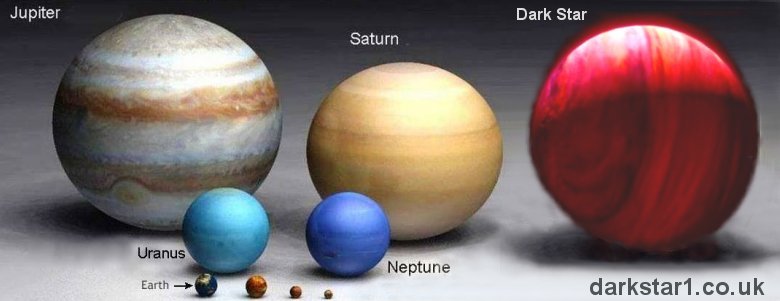
I put to you the exciting possibility that we are in a binary system, but one where the companion remains hidden. It might have its own system of planets, and the heat it generates might be enough to provide life on these orbiting worlds. The possibilities are very exciting indeed.
"Located within the constellation Pisces, the newly spotted object is called HD 3651 B. It is 50 times the mass of Jupiter and thus considered a T brown dwarf-the coolest of the two brown-dwarf categories. This slow smouldering releases infrared light, which was detected by NASA's Spitzer Space Telescope [image] .
"One reason the dwarf stayed out of view until now, Lunham said, is its lengthy distance from its planet partner, which the researchers spotted using the Doppler method. This technique measures the wobbles of a star caused by the gravitational tug of an orbiting object that otherwise can't be detected. However, the method is limited: Whereas the planet orbits at a snug 0.3 astronomical units (AU) from the Sun-like star called HD 3651, the brown dwarf resides at a distance of 500 AU. One AU is the distance between the Sun and Earth." (1)
My proposal is built upon hard evidence, and logical argument. The remarkable evidence supporting this theory is detailed in my book 'Dark Star' (2). The evidence supporting such a theory appears to be building at an exponential rate. Perhaps this would be a good time to acquaint yourself with a new reality?
Wide Binary Brown Dwarf Precedent
The discovery of a brown dwarf just 12 times the mass of Jupiter has excited astronomers studying extra-solar planetary systems.
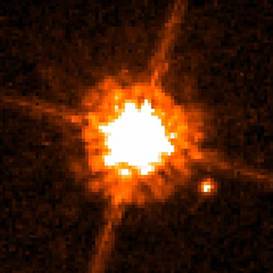
This object is on the edge of planetary status, and is barely large enough to be included in the category of brown dwarf. But what is even more exciting about this discovery, made by Kevin Luhman's team, is that the CHRX-73 system is a wide, low-mass stellar binary.

This brown dwarf/massive planet travels around its larger stellar companion at a whopping 200 Astronomical Units. (This is the kind of distance mooted for Nibiru, a planet with an orbital period of some 3600 years.)
This is puzzling astronomers because such a wide orbit is beyond the scope of planetary formation for the parent star in question. Simply put, this object could not have accreted at such a great distance. So how did it get there? It seems likely that it formed as a 'star', albeit a failed one, in its own right. This is exactly the kind of scenario presented in my book 'Dark Star', and the discovery sets an excellent precedent.
It is surely now impossible for sceptics to argue against small brown dwarfs existing beyond 200AU in our own solar system. Let me explain:
The Only Game in Town
It is thought that planets form by accreting together the dense material of a fledgling star's proto-planetary disk. This enormous disk is a spinning cloud of gaseous matter whose centre condenses into a star. Over time the remainder of the disk clumps into planets. The sizes of disks vary, but a reasonable assumption is that our own Sun had a proto-planetary disc whose substantive radius was about 30-40 Astronomical Units; just over the distance to the planet Neptune. Much bigger than this and one would have to explain where all the planets are beyond Neptune. Given that astronomers can rule out substantial planetary bodies out to about 50AU, it seems reasonable from their point of view to argue that no massive Planet X body could have accreted beyond that point, because the Sun's proto-planetary disk simply wasn't large enough to provide the necessary building blocks for planet formation that far out.
In other words, without large Earth-sized planets turning up just beyond Neptune it seems unlikely to the scientists that massive planets would have formed even further out. The ability to form planets in the disk should tail off beyond Neptune.
But...That assumes that the Sun formed as a singular star with a uniform proto-planetary disk. In fact, evidence from the outer solar system suggests the picture is far more complicated than this, as I have outlined in 'Dark Star'. Additionally, there is a completely different scenario to consider; that the Sun formed as part of a wide binary system, the smaller partner of which is a sub-brown dwarf. Picture the early solar system under these conditions; two spinning clumps of gaseous matter orbit around each other at, say 200 Astronomical Units distance.
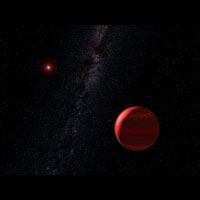
The larger one forms the Sun and its 'classical' proto-planetary disk, the second forms a sub-brown dwarf with its own independent proto-planetary disk. Such a scenario would explain the anomalies of the Edgeworth-Kuiper Belt, where there is an inexplicable gap of objects beyond 50AU. It also provides a very sensible mechanism whereby a brown dwarf could form beyond the classical proto-planetary disk, and be found located in a wide binary orbit with its parent star. This seems to be what's going on with the CHRX-73 wide binary.
I suggest this is what's going on in our solar system. There is a small and rather dark binary companion orbiting the Sun at a great distance, which has been there since the very beginning of the solar system. It has its own independent system of planets, capable of supporting life.
To my mind the Dark Star Theory is the only way to fit all the pieces of the puzzle together. Ufologists puzzle over where aliens come from; how they manage to travel the incredibly immense distances between stars without having the impossible capability of being able to travel faster than the speed of light. The answer is clear as day; they have come from our own cosmic backyard! The distance to a wide binary sub-brown dwarf is no distance at all compared to even the closest star. In a stroke it is possible to lay to one side this chronic enigma.
Written by Andy Lloyd, 13-20th September 2006
author of 'The Dark Star' (2005), 'Ezekiel One' (2009), 'The Followers of Horus' (2010) and 'Darker Stars' (2019)
References:
1) Jeanna Bryner "Distorted Solar System Discovered", 19 September 2006, with thanks to Pat Thomas, David Pearson et al
2) Andy Lloyd "The Dark Star: The Planet X Evidence" Timeless Voyager Press 2005
3) Article on longer available online. With thanks to Phil Whitley
4) Donna Weaver, Ray Villard, B K K "Planet or a Failed Star? . . . Discovery Reveals One of the Smallest Stellar Companions Ever Seen" Penn State University, 7 September 2006
5) European Space Agency "Planet Or Failed Star? One Of Smallest Stellar Companions Seen By Hubble" 8 September 2006
6) Los Alamos National Laboratories



